Kota Kinabalu City Bird Sanctuary
The fieldworker hut seen as one enters the mangrove walk with a water lily pond in the foreground.
The Kota Kinabalu City Bird Sanctuary (KKCBS) is like an oasis surrounded by a sea of development (it's borders are already hemmed in by housing estates and a golf driving range) and this adds much to it's charm and importance as it is an important migratory stopover for birds and home to a diverse mangrove ecology (a unique ecosystem inhabiting a saline and freshwater mix and harsh conditions that discourages normal flora growth). Sadly too is the fact that whereas in the past a network of mangal forests could be found through Kota Kinabalu stretching from the present town center until the still pristine Salut-Mengkabung estuary, many are no longer in existance, cleared away for development (which include large parts of Kk town, the coastal highway, housing development in Likas and even UMS) with the KKCBS patch (24 hectares) being the last mangrove forest in the Kota Kinabalu area. In conjunction with the Likas Lagoon and the long stretch of coastline adjacent to the Coastal Highway, KKCBS provides crucial resting, feeding and nesting grounds for various birds species, mangrove inhabitants and fish species. Mangroves play important ecological roles and with the recent tsunami incident, their importance in floodwater retention, coastal stabilization and buffer zones not to mention habitats for various economically important species, are better acknowledged.
Low tide in the mangroves reveal large tracts of mudflats that is rich in shellfish and crustaceans which the birds delighfully tuck into, low tides are the best times to watch for birds as they settle down to forrage.
KKCBS was designated a bird sanctuary by the state government in September 1996 and later declared as a State Cultural Heritage Site. Along with Likas Lagoon, an open water and vegetation reserve along the Coastal highway and besides the City Mosque, they both form the Likas wetlands. Getting there is quite easy, main bus lines run through the Likas area as well as along the Coastal highway which can be accessed from town (a mere 2 km away) and a little walking is required after that. Driving there is easy with road access and ample parking space. The location map can be found here. It is manned by a handful of permanent staff and manpower is often supplemented by volunteer programmes.
One of several species of mangroves found in the sanctuary, propped roots can clearly be seen, an adaptation of the mangroves to cope with the flooding of the tides.
Various attractions can be found by visitors here. The mangrove is linked by a network of boardwalks (1.5 km) that allows visitors to view the forest and it's inhabitants in relative comfort and ease. The boardwalk brings you close to the inner depth of the mangrove forests, giving you a close look at the unique flora and fauna. Trees are so dense that you are easily shaded as you walk about. Weary visitors can take the opportunity to shelter in the huts provided along that way and knowledge seekers can gleam useful information on mangrove habitats through the signs and information panels scattered throughout. The Rotary Nature Activity Center found in a lagoon in the mangrove clearing hosts various environmental awareness activity programmes that is offered to interested groups. A bird hide allows discreet viewing of birds as they go about their normal habits while a tower hide allows a bird's eye view of the surrounding environment. Towards the end, a gravel path allows a more natural feel for you as you enjoy the sights walking by the river side.
A flowering mangrove.
KKCBS's main role is as a protector of the last vestige of mangrove in the area, preserving and developing it for future generations to enjoy. To the visiting birds and permanent residents, the mangrove provides a rich habitat and feeding grounds. Migratory species are especially welcomed as they can find shelter to refresh their reserves before continuing. Another important roles the staff is in charge of is to educate people in the importance of mangroves and why it is important to maintain them. To fulfill this, KKCBS carries out periodical Education Programmes for all age groups, be it children, teenagers or adults. Group programmes can be arranged with the staff here whereby participants can try their hands at planting young mangrove seedlings, feel first hand trudging through the mud flats and get a closer look at the various animals that inhabit the place. An Environmental Education Center is fully equipped with an audio visual room, exhibition gallery, and a resource library. Volunteer programmes are also available as KKCBS is a non-profit organisation that is limited through the grants and private funding available thus volunteers play an important part in supplementing the permanent workers in carrying out day to day duties such as clearing the mangroves, replanting programmes, monitoring of the site etc.
One of the main intersections of the boardwalk leading to the bird hide, a rest hut can be clearly seen.
The main draw of the place are the birds. Enough varieties and species are clustered in this small haven to please any bird watchers, many photographers are also seen snapping away at the feathery inhabitants. More than 80 species have been reported here, with a large majority of them being waterbirds like herons and egrets. My visit there saw countless of these perched all over the place, resting on the wooden railings, feeding in the mudflats during high tide, nesting in the mangroves or flying overhead in flocks. A breeding population of purple herons are to be found here. Kingfishers, doves, starlings and pigeons are also common residents that you can spot. As this is one of the few places available for feeding and resting, manu migratory birds are easily spotted during their seasonal migration. More elusive are the fishes since they are not easily seen. If you're lucky and sharp eyed you may be able to spot the mudskippers as they make their way through the muck or even the mudlobsters, else you'll just have to settle for the various mud mounds that is their home. Fiddler crabs are more easily spotted, often found near the river banks near the gravel walk, seen feeding or in ritual mating contests (the male has a single elnarged claw that they use to joust with a competitor).
The bird tower where on can have a bird's eye view of the sanctuary.
The KKCBS is open to public 6 days a week from Tuesday to Sunday with Mondays off, it also receives visitors during public holidays. Opening hours are from 8 a.m. to 6 p.m. A small entrance fee (RM 2 for locals, RM 10 for foreigners) is charged for the park's maintenance. Binocular rental (RM 5) is a good idea if you wish to view the birds as they are often a distance away from human presence. For group activities or volunteer or even donations can be made to the office itself. For further details visit the organization's main webpage.

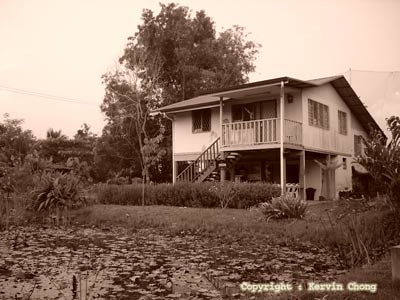
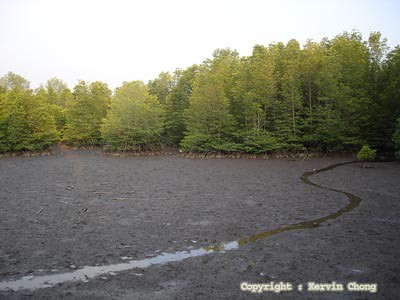
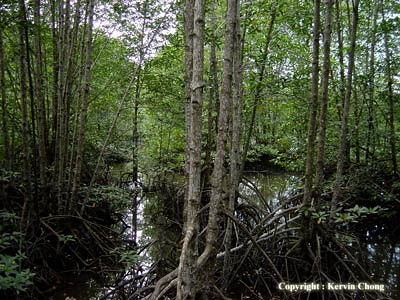
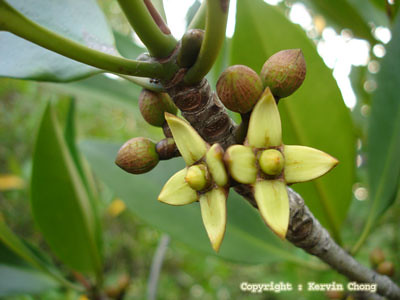
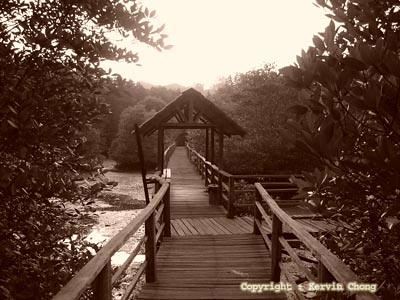
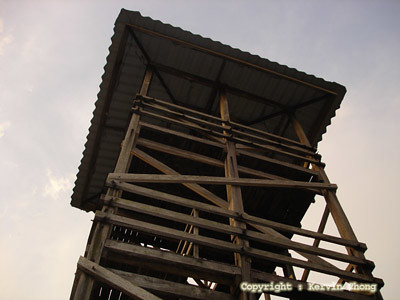
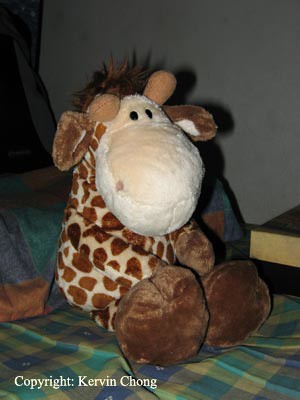

6 comments:
Given how hot it is outside now, your picture of the mangrove trees, gives a sense cool serenity.
BawangMerah: Urgh weather's been horrid, scorching desert weather in the morning and later torrential rain in the evening. My lalang is having a field day in my front yard.
hi,
do u think it is possible and good if that place can be a fishing area
of freshwater fish?
sorry forgot to intro, my name is Desmond Goh, currently do assignment about KKCBS, we need to do some plan to improve KKCBS to be more attractive area. my view is the KKCBS can offer tourist to fishing around by feed freshwater fish inside the paya bakau? how is ur opinion and suggestion ?soree for poor language.
First and foremost KKCBS is a bird reserve with habitat gearing to service the needs of a migratory bird population thus any human use of it would only serve to undermine this. Secondly the terrain is a tidal flat and thus is subject to the ebb and flow of the tide thus rearing fishes is not an option since most of the time the ground is exposed during low tide. Thirdly freshwater species especially those prized by anglers cannot survive in brackish waters. Next up is the intensive use of the habitat would only put stress to the mangroves as well as increased human population would cause the birds to feel disturbed. I'm glad you wish to contribute ideas to increase visitors but a fishing use is not the best option for KKCBS and from my survey there isn't a particular good spot to rear fishes and facilities for anglers.
hola..i read ur opinion as well as ur thoughts about kkcbs just now. how happy i am that people out there getting to know about kkcbs. surely it was a wonderful n a perfect place for nature lover. 2 months spending my life in kkcbs have broaden me with a lot of knowledge about mangrove n wetlands...uh uh b4 that, i would like to introduce my self, but well call me v :) well, that's all 4 now..i'll post my comment sum other time.
Post a Comment